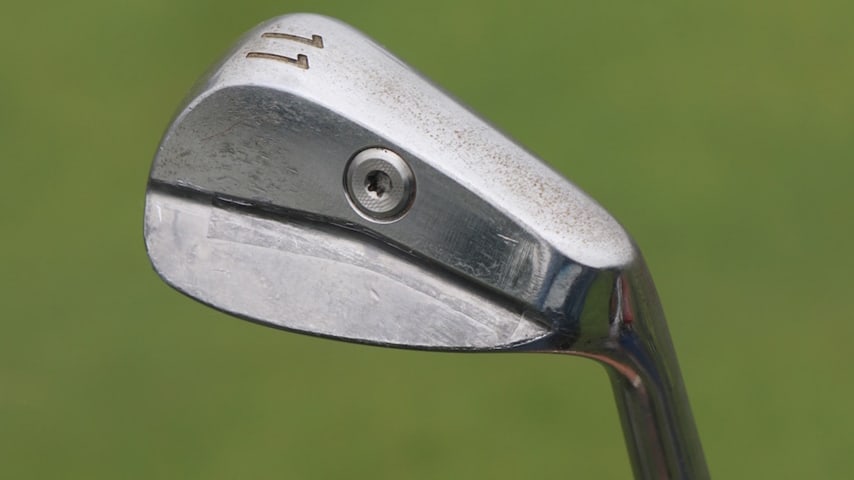A look at Ben Hogan’s 60-year-old prototype clubs
7 Min Read

Written by GolfWRX
At Colonial Country Club, home of this week’s Charles Schwab Challenge, the presence of Ben Hogan, who won five times as a professional on the course (1946, 1947, 1952, 1953 and 1959), is everywhere. The interior of the clubhouse is decorated with photographs and memorabilia from Hogan’s career, and outside the clubhouse, a 7-foot-tall bronze statue of Hogan stands, looming over the golf course.
In further celebration of his legacy this week, the Ben Hogan Foundation – which owns a collection of over 300 clubs from Hogan’s personal stash – allowed PGA TOUR players the chance to hit some of Hogan’s original golf clubs on the range Tuesday at Colonial Country Club.
Golf technology has advanced greatly since Hogan’s playing days, so the opportunity gave modern-day players a chance to experience the difficulties of hitting persimmon drivers and old-school irons. Adding to the challenge, Hogan was a tinkerer and fought a hook throughout his career, so the golf clubs were built specifically for Hogan’s hook-proof swing.
PGA TOUR player Maverick McNealy spoke to GolfWRX on Tuesday about what it was like to try out Hogan’s personal clubs.
“It’s very different,” McNealy explained. “You can tell he has his unique fingerprints all over them. They sit about 10 degrees open, they’re at least 5 degrees flat, soft shafts, no offset, very little bounce. I think someone who’s used to hitting today’s equipment would stick them in the ground and hit kind of a chunk, block, fade. You really have to keep the hands low and rotate hard and release the face to get that thing to be square.”
The Ben Hogan Foundation also brought five of Hogan’s personal prototype golf clubs to Colonial (which players weren’t allowed to hit). According to Robert Stennett, CEO of the Ben Hogan Foundation, the unique clubs are “irreplaceable” and typically locked away in a safe.
On Tuesday, GolfWRX got an exclusive look at the Hogan prototypes, which are estimated to date back to the early 1960s.
“When Mr. Hogan passed, the family left all the clubs in his home, which were substantial, to the director of golf at Shady Oaks Country Club, Mike Wright, who has subsequently donated them to the Ben Hogan Foundation when it was established in 2007,” Stennett explained. “They donated all the clubs to the Ben Hogan Foundation. Similarly, when Spalding closed the Hogan Company here in Fort Worth, all the clubs that were in Mr. Hogan’s office were donated back to Mike Wright and Shady Oaks, and we’ve taken possession of those, as well … we’ve probably got over 300 golf clubs of Mr. Hogan’s, including these prototype clubs.”
As the five golf clubs reveal, Hogan was ahead of his time as a golf club inventor.
Growing up, Hogan’s father was a blacksmith, but when he committed suicide in 1922, 9-year-old Hogan was left to assist his family financially by selling newspapers. At age 11, he began caddying at Glen Garden Country Club, and he eventually dropped out of high school. While Hogan never gained a higher education in science or engineering, his golf intelligence and knowledge of the golf swing helped him create golf clubs in his later years that were truly forward-thinking.
In 1953, amidst his playing career, Hogan founded his own equipment company.
“He created his own company, and my own substantiated belief is he did that because his previous company couldn’t stay up with how rapidly he was making design changes in equipment,” Stennett said. “So he created his own company in 1953. He had his own scientist. I’m sure Mr. Hogan would draw something out on paper, send it in, they would bring a mockup to him, and then they would go back and forth as they were creating new equipment designs. Gene Sheeley was one of his early scientists. He was there for a long time.”
Hogan had ideas to improve golf club design, and alongside his longtime club maker Gene Sheeley, Hogan had both the access and the means to craft experimental golf clubs. While modern-day technology advancements are tested on robotic machines – such as the “Iron Byron” – due to their repeatability, Hogan also served as his own machine tester.
“Mr. Hogan was the ‘Iron Byron,’” Stennett said. “He didn’t have a hitting machine in his day (to test equipment). He would go into the factory, he would go invent, he would go tinker with a club, and he would bring it out to Shady Oaks and he would be the Iron Byron. He would test it, take it back to the factory, tweak it, and these are some of the experimental clubs Mr. Hogan was tinkering with. Most of them subsequently became very famous clubs.”
While the prototype golf clubs in Stennett’s possession didn’t necessarily make it to the retail market, and Hogan didn’t use them in competition, they illustrate Hogan’s foresight and willingness to push boundaries.
“I just brought five examples here,” Stennett said. “It’s one thing to hear (in) my words how creative and how innovative Mr. Hogan was. It’s another thing to show you a club that no one knows about that was perhaps invented 20, 30 years before you’ve heard of the club … his attention to detail was so amazing and he was so meticulous, and he spent so much time investigating and learning the golf swing that equipment design naturally flowed to his love of golf and his interest in pursuing perfection.”
The collection of prototypes that Stennett revealed on Tuesday include a “hybrid,” a driver made of metal, a driver with modern shapes and weighting ideas, an iron made of aluminum with unique grooves, and a putter with the shaft in the toe section instead of the heel.
Check out the photos below to learn a bit more about what makes the clubs so incredible.
Hogan’s “metal” driver
Until 1979, when TaylorMade’s first metalwood hit the market, drivers being used on the PGA TOUR were made of persimmon wood. Metal, however, eventually proved to be longer and more accurate than the wooden predecessors, so persimmon drivers were eventually left behind as artifacts.
This black Hogan prototype driver is estimated to have been created in the early 1960s, years before the first true metalwood was popularized.
Of course, Hogan never brought the driver to market or to PGA TOUR competition, but he was certainly heading down the right path as an inventor and experimenter.
Hogan’s “hybrid”
These days, hybrids are incredibly common on the PGA TOUR and in the retail market. There was a time, though, when the modern hybrid didn’t even exist.
The first long-headed “hybrid” type designs that we know today were the Ginty and Baffler released in the 1970s, but it wasn’t until the late 1990s when Cobra unveiled its Baffler hybrid that the club designs really took off.
Hogan’s all-silver metal hybrid, however, was said to be crafted in the early 1960s, according to Stennett. It doesn’t have any markings, but the shaping is undeniable.
Hogan’s modern-shaped driver head
While most persimmon drivers in the 1960s had a distinct shape that featured wide hosel sections, compact and rounded shapes with narrow hitting areas, this Hogan prototype had elongated heel and toe shaping on the face, a triangular crown, and the shaft entered directly into the clubhead all the way through into the sole in a “bore-thru” construction. Additionally, it appears Hogan added a heavy washer-like weight in the sole, likely to lower the center of gravity in the head.
In modern-day driver head design, we recognize these qualities as helping to raise launch, lower spin and add forgiveness in order to optimize performance. In the 1960s, this design would have been truly one-of-a-kind.
Hogan’s aluminum iron
Although it’s unknown Hogan’s exact intent behind this design, Stennett says the extremely lightweight iron is likely made of aluminum, and the grooves of the head have a wave-like shape. Stennett’s best guess is that Hogan was experimenting with creating more swing speed and trying to manipulate spin of the golf ball using groove construction.
Hogan’s backwards putter
Most putters, even still to this day, have a shaft that enters the club head through the heel section of the putter. This Hogan prototype, however, has a shaft that enters through the toe section.
Although multiple companies have since experimented with similar shaft placement, the design never quite gained as much popularity as his other prototypes on this list. The putter does, however, illustrate Hogan’s willingness to try anything and everything in order to improve. He was constantly chasing perfection.
Note: If you want to see the prototype clubs in person, or any of the clubs from Hogan’s collection, reach out to Robert Stennett of the Ben Hogan Foundation for a personal tour. You can also see a selection of the clubs at the Ben Hogan Museum in Hogan’s hometown of Dublin, Texas. Click here for more on the Ben Hogan Foundation and learn how to get involved.











